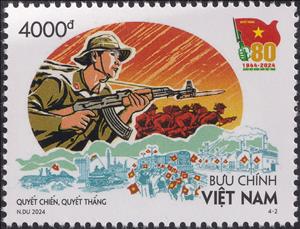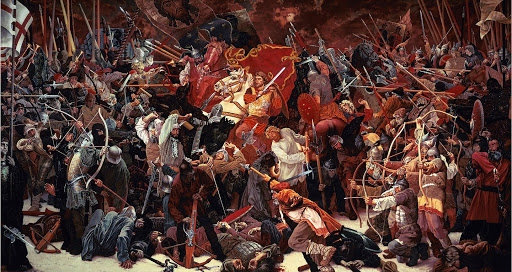Stamp: Determined to Fight, Determined to Win (Vietnam 2024)
Determined to Fight, Determined to Win (Vietnam 2024)
18 December (Vietnam ) within release People's Army of Vietnam, 80 Years (2024) goes into circulation Stamp Determined to Fight, Determined to Win face value 4,000 Vietnamese đồng
| Stamp Determined to Fight, Determined to Win in catalogues | |
|---|---|
| Colnect codes: | Col: VN 2024.12.18-02 |
Stamp is horizontal format.
Also in the issue People's Army of Vietnam, 80 Years (2024):
- Stamp - Determined to Fight, Determined to Win face value 4,000;
- Stamp - From the People, Fighting For the People face value 4,000;
- Stamp - Ready to Fight and Protect the Fatherland face value 4,000;
- Stamp - The Army and People Under One Determination face value 15,000;
Stamp Determined to Fight, Determined to Win it reflects the thematic directions:
An anniversary is the date on which an event took place or an institution was founded in a previous year, and may also refer to the commemoration or celebration of that event. For example, the first event is the initial occurrence or, if planned, the inaugural of the event. One year later would be the first anniversary of that event. The word was first used for Catholic feasts to commemorate saints. Most countries celebrate national anniversaries, typically called national days. These could be the date of independence of the nation or the adoption of a new constitution or form of government. The important dates in a sitting monarch's reign may also be commemorated, an event often referred to as a "Jubilee".
A battle is an occurrence of combat in warfare between opposing military units of any number or size. A war usually consists of multiple battles. In general, a battle is a military engagement that is well defined in duration, area, and force commitment.
A military, also known collectively as an armed forces, are a heavily armed, highly organized force primarily intended for warfare. Militaries are typically authorized and maintained by a sovereign state, with their members identifiable by a distinct military uniform. They may consist of one or more military branches such as an army, navy, air force, space force, marines, or coast guard. The main task of a military is usually defined as defence of their state and its interests against external armed threats.
A people is a plurality of persons considered as a whole, as is the case with an ethnic group or nation. Collectively, for example, the contemporary Frisians and Danes are two related Germanic peoples, while various Middle Eastern ethnic groups are often linguistically categorized as Semitic peoples.




